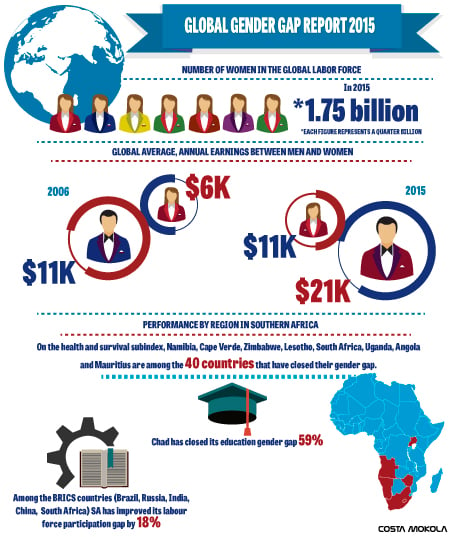Gender diversity and the pay gap in SA
Concerns and suggestions.

“If women are not provided with adequate access to education and employment opportunities, at least half of a country’s potential might be lost”. This warning by Michelle Bachelet, the executive director of the United Nations Entity for Gender Equality and the Empowerment of Women, shows that gender equality is not just about doing the right thing, but it also makes economic sense.
According to the World Bank, the participation rate of women in the South African economy was approximately 45% in 2014. Enabling legislation might have played a role in encouraging greater gender diversity. Affirmative action measures to redress the disadvantages experienced by designated groups, including women, are set out in the Employment Equity Act (No. 55 of 1998).
Although retraced for further consultation, the proposed National Women Empowerment and Gender Equity Bill (2014) called for the progressive appointment of at least 50% women in decision-making structures. In line with the bill’s critics, we also question whether such legislation could bring about real social justice. In 402 BC the Greek philosopher Plato claimed that good people (companies) do not need laws to tell them to act responsibly, while bad people (companies) always find a way around the law.
Despite their considerable economic contribution, South African women earned approximately 34% less than their male counterparts for the same job in 2015. This discrepancy is known as the gender pay gap. Researchers documented education and age as additional factors that might contribute to this gap. The Employment Equity Amendment Act (No. 47 of 2013), which came into effect in 2014, introduced the concept of “equal work for equal pay”. This amendment now allows females to demand the same emolument as males who perform similar work.
A country’s economy depends to a large extent on the efficiency of listed companies (and by implication their highest ranking decision makers). Local executive directors, who are responsible for executing a company’s strategy, are typically males. Despite a minor increase in the number of female executive directors, women are generally appointed as non-executive directors (NEDs). Such directors primarily have a monitoring role. The current state of affairs could be partly attributed to the so-called glass ceiling. This perceived barrier limits women from climbing the corporate ladder, despite their qualifications and achievements being on par with those of their male counterparts. Limited female representation on board level among JSE-listed companies is lamentable, given that empowered female executives might contribute considerably to the performance of their companies and the local economy.

According to the King III Report (2009), directors should be fairly rewarded for services rendered. We consequently set out to investigate the remuneration of male and female directors of the 40 largest companies listed on the JSE over the period 2011 to 2014. We firstly considered the difference between the remuneration packages of male and female executive directors. In line with the King III Report’s recommendations, executive directors may receive salaries, bonuses, retirement plans, share options and other long-term incentives based on their performance. We secondly evaluated the difference between the fees of male and female NEDs. The King III Report states that NEDs may receive a base fee and a fee for attending meetings.
The majority of directors in the sample (more than 80%) were male. The number of female directors increased slightly over the study period. These appointments were mainly NEDs. When considering executive directors’ average total remuneration packages, males earned significantly more than females. In addition, the difference in the mean total remuneration packages received by male and female executives increased over the research period. The same picture emerged when investigating long-term incentives, such as share-based schemes. A statistically significant difference was furthermore noted between the fees paid to male and female NEDs.
Our findings are in line with other researchers who suggest that there is much room for improvement when it comes to the number of female board appointments and their fair emolument in South Africa. We would like to offer some recommendations to address this situation. In the first instance, we are of the opinion that local companies should spend more resources on the development of a diverse workforce, particularly at board level. Female board candidates can be mentored by experienced board members. Alternatively, female shadow directors can gain some valuable experience before they have to bear the full burden of their corporate and fiduciary duties.
A further suggestion is that nomination committees of all listed companies should nominate more capable female executive and non-executive directors. The onus then falls on shareholders to elect the nominated female candidates and ask probing questions regarding the gender pay gap. We strongly recommend that the King III Report’s non-binding vote on companies’ remuneration policies should be amended. Options in this regard include a binding vote (as in the UK) or a two-strikes rule (as in Australia). Fortunately, this matter is set to be addressed in the forthcoming King IV Report.
*Dr Nadia Mans-Kemp and Prof Suzette Viviers are academics in the Department of Business Management at Stellenbosch University. Frances van der Vyver was a postgraduate student at the same department in 2015.
Brought to you by Moneyweb
For more news your way
Download our app and read this and other great stories on the move. Available for Android and iOS.









